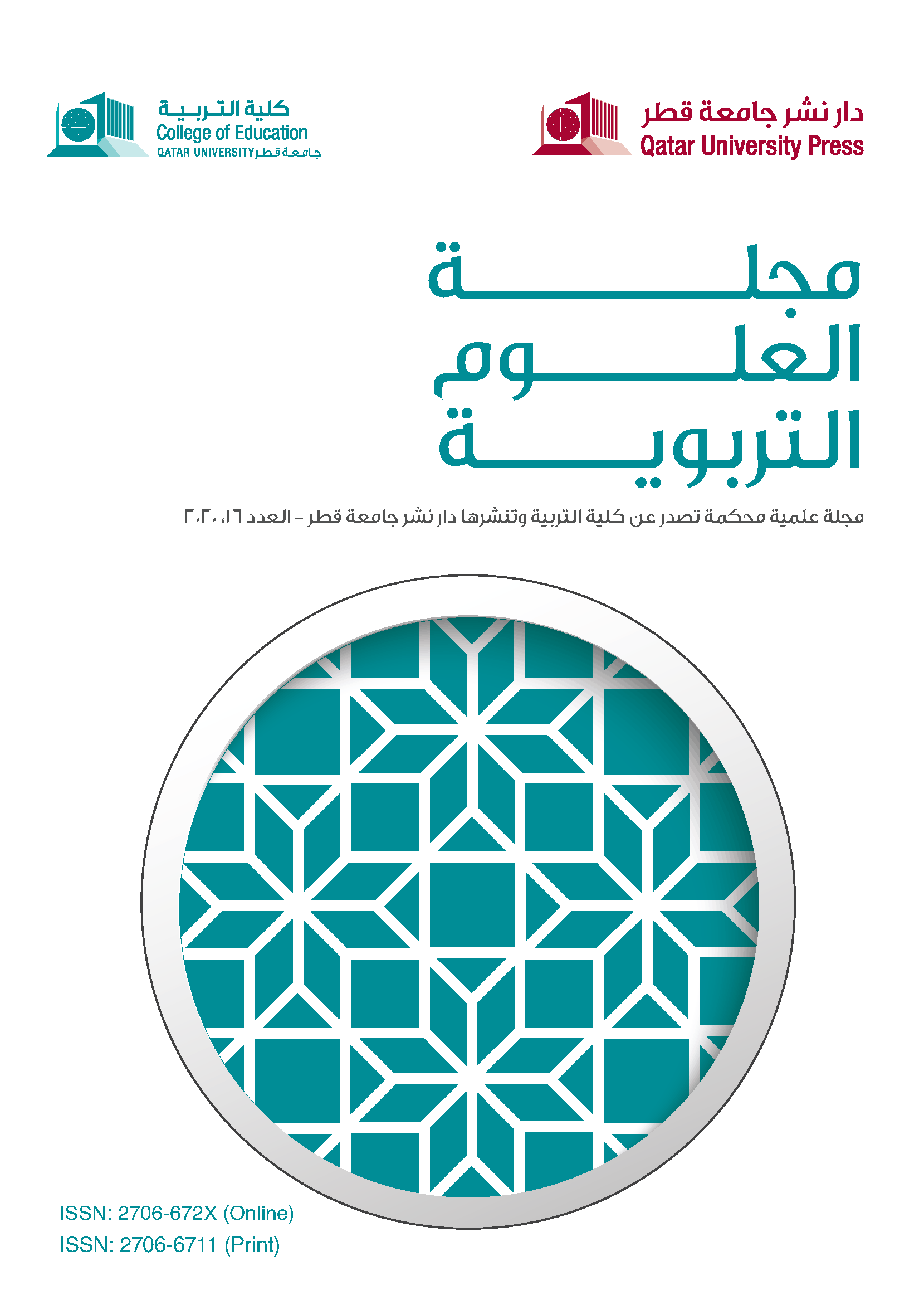الخصائص السيكومترية لمقياس هكساكو-60 للعوامل الستة للشخصية على عينة من طلبة المدرسة والجامعة في سلطنة عمان
الملخص
هدفت الدراسة للتحقق من الخصائص السيكومترية لمقياس هكساكو-60 للعوامل الستة للشخصية، على عينة من طلبة المدرسة والجامعة في سلطنة عمان. وقد تكونت عينة الدراسة من 784 طالبًا وطالبة من الصفين التاسع والحادي عشر (متوسط العمر 15.31 عامًا). أجاب 444 منهم على نسختي التقرير الذاتي، وتقييم الأقران؛ بينما أجاب الآخرون على نسخة التقرير الذاتي فقط. بالإضافة إلى ذلك، فقد تكونت العينة أيضًا من 421 طالبًا وطالبة من المرحلة الجامعية (متوسط العمر 19.94 عامًا)، أجابوا على استمارة التقرير الذاتي فقط. تم التحقق من البنية العاملية للمقياس باستخدام التحليل العاملي التوكيدي، وقد أوضحت النتائج وجود بنية عاملية بستة عوامل مكونة من 51 عبارة في كل من نسختي التقرير الذاتي وتقييم الأقران على عينة المدرسة، وبنية عاملية بستة عوامل مكونة من 60 عبارة على طلبة الجامعة. كما أشارت النتائج إلى وجود مؤشرات حسن مطابقة ومعاملات ثبات جيدة للمقياس، فيما عدا انخفاض معامل الثبات لكل من عاملي الانفتاح على الخبرة والقبول؛ لذلك، من المهم الحذر عند استخدام مقياس هكساكو-60 في سلطنة عمان، مع أهمية إجراء دراسات أخرى للتحقق من خصائصه السيكومترية على عينات مختلفة.
المقاييس
##plugins.themes.bootstrap3.article.details##
الشخصيةهكساكو-60البنية العامليةسلطنة عمان
الأنصاري، بدر. (1997). مدى كفاءة قائمة العوامل الخمسة الكبرى للشخصية في المجتمع الكويتي. دراسات نفسية، 7(2)، 277-310.
الأنصاري، بدر. (2000). قياس الشخصية. الكويت: دار الكتاب الحديث.
تيغزة، أمحمد بوزيان. (2012). التحليل العاملي الاستكشافي والتوكيدي: مفاهيمهما ومنهجيتهما بتوظيف حزمة SPSS وليزرل LISREL. عمّان: دار المسيرة للنشر والتوزيع والطباعة.
حسن، عزت. (2008). الإحصاء المتقدم للعلوم التربوية والنفسية والاجتماعية: تطبيقات باستخدام برنامج ليزرل 8.8 LISREL 8.8. بنها: دار المصطفى للطباعة والترجمة.
كاظم، علي. (2001). نموذج العوامل الخمسة الكبرى في الشخصية. المجلة المصرية للدراسات النفسية، 30، 277-299.
كاظم، علي. (2002). القيم النفسية والعوامل الخمسة الكبرى في الشخصية. مجلة العلوم التربوية والنفسية، 3، 12-42.
الكلباني، منى. (2006). تقنين قائمة العوامل الخمسة الكبرى للشخصية على طلبة جامعة السلطان قابوس، رسالة ماجستير غير منشورة. سلطنة عمان: جامعة السلطان قابوس.
اللواتي، عصام. (2004). العوامل الخمسة الكبرى في شخصية مدير المدرسة وعلاقتها بكفاءته في إدارة أدوارة الأساسية في سلطنة عمان، رسالة ماجستير غير منشورة. سلطنة عمان: جامعة السلطان قابوس.
يونس، فيصل وخليل، إلهام. (2007). نموذج العوامل الخمسة للشخصية: التحقق من الصدق وإعادة الانتاج عبر الحضاري. دراسات نفسية، 17، 553-583.
المراجع الإنجليزية
Al-Attiyah, A., Megreya, A., Alrashdi, M., Alexis, S., Lara, D., & Al-Sheerawi, A. (2017). The psychometric properties of an Arabic version of the personality inventory for DSM-5 (PID-5) across three Arabic speaking Middle Eastern countries. International Journal of Culture and Mental Health, 10, 197-205, doi:10.1080/17542863.2017.1290125.
Ashton, M., & Lee, K. (2001). A theoretical basis for the major dimensions of personality. European Journal of Personality, 15, 327-353, doi:10.1002./per.417.
Ashton, M. et al. (2004). A six-factor structure of personality-descriptive Adjectives: Solutions from Psycholexical Studies in Seven Languages. Journal of Personality and Social Psychology, 86, 356-366, doi: 10.1037/0022-3514.86.2.356.
Ashton, M., & Lee, K. (2009). The HEXACO-60: A Short Measure of the Major Dimensions of Personality. Journal of Personality Assessment, 91, 340-345.
Boies, K. et al. (2004). Psychometric properties of scores on the French and Korean versions of the HEXACO personality inventory. Educational and Psychological Measurement, 64, 992-1006, doi: 10.1177/0013164404267277.
Costa, P., & McCrae, R. (1992). Normal personality assessment in clinical practice: The NEO personality inventory. Psychological Assessment, 4, 5-13.
Clifton, A., Turkheimer, C., & Oltmanns, T. (2005). Self- and peer perspectives on pathological personality traits and interpersonal problems. Psychology Assessment, 17, 123-131, doi:10.1037/1040-3590.17.2.123.
De Vries, R., Lee, K., & Ashton, M. (2008). The Dutch HEXACO personality inventory: psychometric properties, self–other agreement, and relations with psychopathy among low and high acquaintanceship dyads. Journal of Personality Assessment, 90, 142-151, https://doi.org/10.1080/00223890701845195.
De Vries, R. (2013). The 24-item brief HEXACO inventory (BHI). Journal of Research in Personality, 47, 871-880, http://dx.doi.org/10.1016/j.jrp.2013.09.003.
Hambleton, R. (2005). Issues, designs, and technical guidelines for adapting tests into multiple languages and cultures. In R. Hambleton, P. Merenda & C. Spielberger (Eds.), Adapting educational and psychological tests for cross-cultural assessment (pp.3-38). Hillsdale, NJ: Lawrence Erlbaum Publishers.
Ion, A. et al. (2017). A Cross-cultural analysis of personality structure through the lens of the HEXACO model. Journal of Personality Assessment, 99, 25-34, doi:10.1080/00223891.2016.1187155.
Lee, K., & Ashton, M. (2004). Psychometric properties of the HEXACO personality inventory. Multivariate Behavioral Research, 39, 329-358.
Lee, K., & Ashton, M. (2008). The HEXACO personality factors in the indigenous personality lexicons of English and 11 other languages. Journal of Personality, 76(5), 1001-1054, doi: 10.1111/j.1467-6494.2008.00512.
Lee, K. et al. (2008). Predicting integrity with the HEXACO personality model: Use of self- and observer reports. Journal of Occupational and Organizational Psychology, 81, 147-167, doi: 10.1348/096317907X195175.
Lee, K., & Ashton, M. (2016). Psychometric properties of the HEXACO-100. Assessment, 1-15 (no volume), doi: 10.1177/1073191116659134.
McCrae, R., & Costa, P. (1987). Validation of the five-factor model of personality across instruments and observer. Journal of Personality and Social Psychology, 52, 81-90.
McCrae, R.et al. (1998). Cross- cultural assessment of the five-factor model: The revised NEO personality inventory. Journal of Cross-Cultural Psychology, 29, 171-188.
Međedović, J. et al. (2017). The HEXACO personality inventory: validation and psychometric properties in the Serbian language. Journal of Personality Assessment, 1-7 (no volume), https://doi.org/10.1080/00223891.2017.1370426.
Romero, E., Villar, P., & Lopez-Romero, L. (2015). Assessing six factors in Spain: Validation of the HEXACO-100 in relation to the Five Factor Model and other conceptually relevant criteria. Personality and Individual Differences, 76, 75–81, http://dx.doi.org/10.1016/j.paid.2014.11.056.
Saucier, G., & Goldberg, L. (1996). Evidence for the big five analyses of familiar English personality adjectives. European Journal of Personality, 10, 61-77.
Thielmann, I. et al. (2017). On measuring the sixth basic personality dimension: A comparison between HEXACO honesty-humility and big six honesty-propriety. Assessment, 24, 1024-1036, https://doi.org/10.1177/107319111663841.
Wasti, A., Lee, K., & Somer, O. (2008). Six Turkish personality factors and the HEXACO model of personality structure. Journal of Cross-Cultural Psychology, 39, 665-684, doi:10.1177/0022022108323783.
Aldhafri, S., & Almahrouqi, B. (2016, November). Translation Variation Effects on the Psychometric Proprieties of some Psychological Measures. Paper presented at the 3rd International Conference on Language, Linguistic, Literature and Translation Connecting the Dots in a Globalized World, Sultan Qaboos University, Muscat, Oman.


